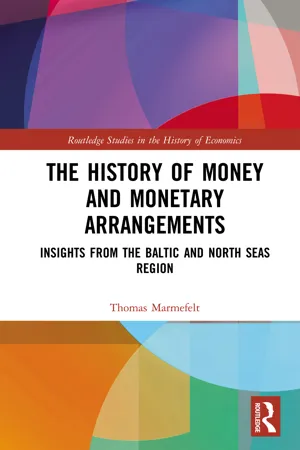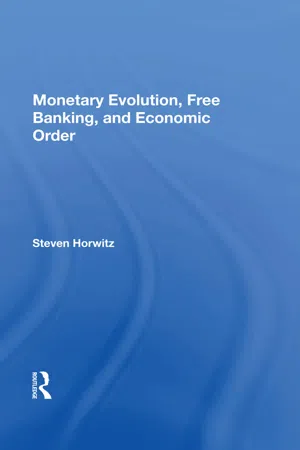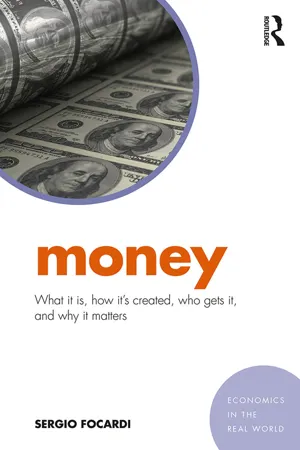Economics
Evolution of Money
The evolution of money refers to the historical development of various forms of currency and exchange systems used by societies. It encompasses the transition from barter systems to the use of commodities as money, and eventually to the adoption of standardized coins and paper currency. This evolution has been influenced by economic, social, and technological factors, shaping the modern financial systems we have today.
Written by Perlego with AI-assistance
Related key terms
7 Key excerpts on "Evolution of Money"
- eBook - ePub
The History of Money and Monetary Arrangements
Insights from the Baltic and North Seas Region
- Thomas Marmefelt(Author)
- 2018(Publication Date)
- Routledge(Publisher)
Evolution of monetary arrangements1.1 IntroductionThis book is about the historical evolution of monetary arrangements, considering specific historical contexts. However, the problem considered is the current emergence of intangible money, which warrants attention to the functional separation of unit of account from medium of exchange. Hence, rather than considering the Evolution of Money, like Orrell and Chlupatý (2016), this book considers the co-evolution of units of account and media of exchange in different historical trading contexts, focusing on four historical cases in the Baltic and North Seas region, from the Hanseatic League to seventeenth century exchange banks, the gold standard and monetary unions, and interwar monetary fragmentation. Finally, some lessons are drawn about the interaction of cognition and institution for money as a social institution.Money as a social institution – a clearing device for the settlement of accounts – rather than a commodity is essential, since the book is about credit money and monetary arrangements that give appropriate liquidity to the real economy, since most money today is credit money, which is created by banks when they give credit. This approach differs from the conception of money as a commodity that would entirely focus on the silver, copper, and gold content of coins. When using the conception of money as a clearing device, the value of money is not based on the metal content, but on some shared agreement of what purchasing power money gives. Here, the interaction between abstract units of account and media of exchange being commodity money or fiat money is of interest. The credit money approach brings in the bills of exchange as private money, which has liberated money from the constraints of precious metal.The aim of this book is to study the Evolution of Money and credit as social institutions, considering the interaction between the cognitive and behavioral aspects of these institutions. In human societies, money and markets are interdependent. As Clower (1999) argues, monetary exchange arises from the same forces of self-interest that induce individuals to make markets; some transactors becoming marketors, eventually specializing, but what constitutes money depends on what country we are in, when we are there, and where we are. Orrell and Chlupatý (2016) argue that money created its own markets and institutions as well as its own demand, and the credit systems of ancient Mesopotamia predated the use of coins. Hence, credit money, not commodity money is the origin of money, and the money on which this book focuses. - Steven Horwitz(Author)
- 2019(Publication Date)
- Routledge(Publisher)
4The Evolution of Monetary OrderHaving seen the crucial communicative role that money plays in social and economic order, we need to examine in more detail the ways in which money is supplied to the market process and the kinds of institutions that are more likely to lead to monetary order, thus enhancing overall economic order. In particular, we can look at how monetary institutions evolve from the simple use of money, and how those institutions fit in to the broader evolution of the market process.A monetary order will, as we have seen, be more than simply the emergence of a medium of exchange. The use of money opens up many new horizons within economic interaction. Money makes possible economic calculation and provides entrepreneurs with profit-and-loss signals that guide their production plans, leading to an increase in rationally allocated resources and the division of labor. These developments, along with double-entry bookkeeping and accounting skills in general, increase the complexity of the market process.The evolution of simple monetary exchange and economic calculation stimulates and necessitates the increased use of money and provides incentives for the further evolution of monetary institutions. Banks, demand deposits, currency, clearinghouses, and other extensions of the financial industry come into being and evolve during this process of economic development. The increased complexity of the creative development of money requires coordination through more advanced monetary institutions. To be able to maintain a high degree of economic order, a properly functioning and sufficiently complex set of monetary institutions is necessary. Both the features of, and the interactions between, these advanced, complex monetary institutions constitute a monetary order. We can characterize the contents of this chapter in three questions: (1) how might these various monetary institutions freely evolve from the simple use of money? (2) Can these freely evolved institutions be fruitfully examined and judged by the approach of Chapter 2 ? and (3- eBook - ePub
Money
What It Is, How It's Created, Who Gets It, and Why It Matters
- Sergio M. Focardi(Author)
- 2018(Publication Date)
- Routledge(Publisher)
3 What is Money?This chapter discusses the nature of money. After some historical remarks, we discuss the various forms of money: commodities, coins, banknotes, credit money, and, lastly, new forms of money including near-money and the shadow banking system, and alternative currencies including digital currencies and local currencies. The concept of credit money – a concept that lends itself easily to much confusion – is discussed, distinguishing credit money (1) as money redeemable into banknotes, (2) as purchasing power, and (3) as bank deposits associated with loans. The chapter closes with a discussion of two competing theories on the general nature of money, the Metallists (who argue that money must have intrinsic value) and the Chartalists (who argue that money is fiat money).3.1 Some brief remarks on money throughout history
The historical perspective on money found in textbooks is that money evolved from barter. Paul Samuelson (1976, pp. 274–276), for example, describes the development of money in several stages, from barter to commodity money, to paper money, and lastly to credit money (bank money in the terminology of Samuelson). The mathematical models of coins discussed in Chapter 4 adopt the same basic perspective.Textbooks typically describe primitive societies without money where goods are exchanged through barter. Note that the notions of ownership and exchange must have developed more or less in parallel, possibly in forms different from the current notion of ownership. But barter might be inconvenient: it requires that the bartering parties want to exchange things of the same value, the “double coincidence of wants,” a term first used by Stanley Jevons (1875). As is explained in textbooks, in order to overcome the fundamental limitations of barter, societies began to adopt divisible objects such as grain, cowry shells, or some form of metals as a medium of exchange and/or standard of value. An early example of this comes from Bronze Age Sumeria where the urban revolution led to an increase in the exchange of goods and services which in turn created the need for a common standard for measuring and valuing goods. The first widely accepted standard there was barley, the basis of Sumerian life. In the Early Dynastic period (2900–2350 BC), though wages and rents were still mostly paid in barley, units of metal – silver and, for small sums, copper – were already the most generally accepted medium and standard of exchange; they were to remain so for the next 2,000 years in Mesopotamia. With the adoption of a conventional metallic standard, the transition from a natural economy based on barter to a money-based economy had been made.1 - eBook - ePub
How Credit-money Shapes the Economy: The United States in a Global System
The United States in a Global System
- Robert Guttmann(Author)
- 2016(Publication Date)
- Routledge(Publisher)
Part II The Historic Evolution of Money Management 4 The Transition from Commodity-Money to Credit-Money In the last two chapters we analyzed essential characteristics of our capitalist market economy: the mobilization of economic activities in the form of interdependent monetary circuits; the investment of money as capital for accumulation purposes; the coexistence of "industrial" and "financial" forms of money-capital; and the unstable (business-cycle and long-wave) dynamics of their expansion. This analysis makes it clear that money plays a crucial role in our economy. We can now proceed to see how money creation, credit financing, and production activities interrelate as an organizing force in the accumulation process to shape a given growth pattern. The precise configuration of this triangular relation depends on a variety of institutions and policies regulating money and credit. Together these form a distinct substructure of the prevailing accumulation regime, the so-called monetary regime. 1 We start this chapter by first defining at greater length what such a monetary regime consists of and how it is supposed to work. Then we analyze its historic evolution in the United States, with special emphasis on the gradual crowding out of the gold standard by credit-money. 4.1. Defining the Concept of Monetary Regimes The monetary regime, a crucial institutional form of any given accumulation regime (see section 3.4), includes several distinct and interrelated dimensions. 1) The Money-Creation Process. Given the strategic role of money (as income and capital) in our economy, the modalities of its creation are bound to have a major impact. If certain private agents were able to create their own money and impose it as a socially accepted medium of exchange, they would obviously gain an unfair advantage over all other market participants who lacked this power. They could simply issue new money to increase their purchasing power or pay off their debts - eBook - ePub
Paper Money Collapse
The Folly of Elastic Money
- Detlev S. Schlichter(Author)
- 2014(Publication Date)
- Wiley(Publisher)
Part Four A History of Paper Money and How We Got to Where We Are NowPassage contains an image
Chapter 7 A Legacy of Failure
Once a commodity of essentially fixed supply becomes generally accepted as a medium of exchange, society can reap all the benefits from the use of money and all the advantages from indirect exchange by using this type of money. Nothing can be gained from ongoing money production, whether private or public, or from competition between currency providers or between alternative monies. Obviously, competition and innovation still matter for all sorts of financial services related to money. Here, the same rules apply that apply to all goods and services that have use value. But no economy needs an expanding supply of the medium of exchange. People buy and sell the monetary asset according to their individual demand for money, and this will lead to changes in the purchasing power of the monetary asset, which are sufficient to align demand for money with the fixed supply of money.Money will never be “neutral.” Changes in money demand affect the monetary unit’s purchasing power but also change relative prices and thus feed back into the “real” economy. Such disturbances are the price we have to pay for enjoying the incalculable advantages of indirect exchange, of trading with the help of money. We have also seen that whatever disturbances emanate from money, they are vastly greater in a system of elastic money. Replacing inelastic commodity money with elastic paper money must lead to economic dislocations, to the obstruction of the pricing process, to ongoing decline in money’s purchasing power, and increasingly to economic disintegration. - Georgina M. Gómez(Author)
- 2018(Publication Date)
- Routledge(Publisher)
This theory on the emergence of monetary singularity has been criticised from both the analytical and empirical angles. Among other arguments, some authors note that it is difficult to see how money could have been unified across civilisations that barely communicated with each other. Moreover, it is counterintuitive to think that this coinage could reduce the transaction costs of bartering (Goodhart, 1998; Wray and Forstater, 2006). Medieval coins were extremely varied in weight, denomination, alloy and fineness; they were chipped and adulterated in various ways, and sometimes they had the same face value but different exchange value. For example, in Merovingian Gaul there were 1200 currencies, most of them issued by private individuals (MacDonald, 1916 quoted in Wray, 1998). Besides, transaction costs could hardly have been the driving force behind creating monetary singularity. There were complex civilisations, advanced in production and trade and with a few million inhabitants like the Incas or the Phoenicians, that managed their economy without any kind of money (Melitz, 1974). John Maynard Keynes, unlike Hicks, considered that commodity money might have functioned as a ‘convenient medium of exchange . . . but if this is all, we have scarcely emerged from a state of barter’ (Keynes, 1976 [1930]: 3). There is more to the origins of a single money than the preference for a commodity. This explanation on the evolution from gold to scrip is not credible, especially after the abandonment of the gold standard and the dissemination of electronic and digital money.The alternative draws from sociology and heterodox economics as an institutional theory of money. This version does not dispute that specific commodities have originated as a means of payment throughout history but rejects that these were self-organised choices that resulted from the inherent efficiency of one of these money-things. Instead, Ingham argues that a monetary system is a set of institutions embedded in a society (1996, 2004, 2006). The construction of money follows an evolutionary structuration process along the social, economic and political needs, and possibilities that rose with impersonal exchange (Seyfang and Pearson, 2000). When a community grows, it requires a standard and stable unit of account as reference of value (Aglietta, 2002). The money-thing was present but its transition as unit of account was not spontaneous.The institutionalist view has several strands because they emphasise different aspects. One strand places the origin of money as credit money and argues that it did not emerge out of barter but out of obligation to cancel debts with various authorities, such as sovereigns or priests to whom religious payments had to be made (Wray, 1998, 2004). These local, religious or community authorities would create a unit of account when they proclaimed that they would accept certain money-things at explicit values to cancel taxes and religious debts. While barter was used for local and small trade, larger transactions such as dowries and interregional trade were conducted on the basis of credit (Innes, 1913).- eBook - ePub
The Evolution of Everything
How Small Changes Transform Our World
- Matt Ridley(Author)
- 2015(Publication Date)
- Fourth Estate(Publisher)
15The Evolution of Money
And trickles of silver and gold, also copper and lead, would stream And pool in the earth’s hollows. When cooled, men saw the gleam Of their glinting colours in the soil, and drawn to what they’d found – The shiny smoothness of the nuggets – pried them from the ground, And saw these bore the shapes of the depressions where they lay. Then this drove home that they could shape the nuggets in this way – Melting them down and pouring them into any mould they made.Lucretius, De Rerum Natura , Book 5, lines 1255–61Money is an evolutionary phenomenon. It emerged gradually among traders, rather than being created by rulers – despite the heads of kings on the coins: those just illustrated the tendency of the powerful to insist on monopolies. And there is absolutely no reason why money must be a government monopoly. There’s a story that illustrates this, from the dawn of Britain’s Industrial Revolution. In the eighteenth century more and more poor people started moving to towns and working for wages rather than staying in their rural villages and being paid in kind by their semi-feudal employers. This presented employers with a new problem – a shortage of coins. There were gold guineas in circulation for the rich to use, but too few silver crowns or shillings, or copper pennies or halfpennies. Silver coins were worth more, in gold, in China than at home, so they tended to be melted down and shipped east, while the Royal Mint sniffily refused to mint more for most of the eighteenth century. Existing silver shillings were deteriorating in quality. As for the Bank of England, it would issue no paper notes smaller than £5. The entrepreneurs of Birmingham, unable to pay wages in silver, found too few copper pennies available and resorted to using counterfeits, which were abundantly if illegally supplied to them in the back streets.
Learn about this page
Index pages curate the most relevant extracts from our library of academic textbooks. They’ve been created using an in-house natural language model (NLM), each adding context and meaning to key research topics.






